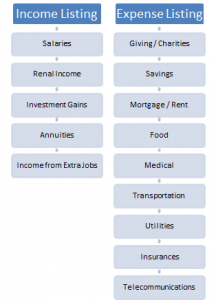In 10 Power Steps to Creating a Killer Personal Budget – Part 1, I described the first five steps to creating and maintaining an effective personal budget. Steps #6 through #10 are detailed in this post.
Just to review, Step#1 through #5 are:
- Find Your Motivation
- Identify Your Financial Goals
- Analyze Your Spending
- Categorize Your Spending, and
- Review Your Income Sources
The most important of these is Power Step#1. As you push forward to complete the next Power Steps, you will need to revisit your motivation, i.e. your reasons for achieving your financial goals. Review your motivation, renew your commitment to complete your budget, and restore your faith. Focus in on one of my favorite mind renewal scriptures in Romans 12:2 [AMP]:
Romans 12:2Do not be conformed to this world (this age), [fashioned after and adapted to its external, superficial customs], but be transformed (changed) by the [entire] renewal of your mind [by its new ideals and its new attitude], so that you may prove [for yourselves] what is the good and acceptable and perfect will of God, even the thing which is good and acceptable and perfect [in His sight for you].
Now, let’s get started with Power Step#6.
Power Step#6: Tabulate and Summarize Income vs. Expenses
Financial awareness begins when you are able to track your income vs. your expenses for a specified period of time, like one month. In Part 1, you were to choose a recording tool to aid you in your budget creation process, like an electronic spreadsheet, or a financial planning software like Mint.com or YNAB (You Need a Budget) software.
You may also have collected some paper and pen notes of your expenses. Load up your spreadsheet or get your notes into plain view. You should also have created several spending categories and grouped your expenses by those categories.
The objective now is to get the income and expenses side-by-side. Now, list your record of income(s) in the left column and your record of expenses in the right column. Total the income column. Then, total the expense column.
This table is now a measure of where you are for the month. If the sum of the month’s expenses are greater than the month’s income, “Houston, we have a problem!” It could also mean you may need to expand the period of your review, if perhaps you have enough leftover from previous periods to cover this month’s shortfall. Hopefully, your analysis shows your total spending for the month is less than, or equal to your income. At this point, you can determine an average spending per category.
Now, let’s define a target spending number for each expense category. For example, if your grocery bills average $400.00 per month, you can now set the grocery category target spending to say, $400.00. Repeat this exercise for each spending category, until you have target for every spending category. This is the stuff a budget is made of!
Now, you can compare your actual monthly spending to each target spending category to examine which areas seem to be the largest contributor to an overage. Work to stay within the spending targets in each category as you spend throughout the month. Using a holistic view, you can then manage the overall spending so that the sum of all spending is at budget. Some categories may be over target, but, certainly manage the sum total so that the final numbers indicate you’ve spent less than you earn.
As you gain experience with using your new budget, you’ll realize where the chronic overspending categories are. Now that you can easily identify overspending areas, let’s talk about correcting those consistently over spent areas.
Power Step#7: Correct Overspending Areas
Try these diagnostic points when working to correct a chronically overspent category:
- Identify repetitive patterns. They are usually linked to consistent behavior, like going to the mall each payday, perhaps eating out everyday because you don’t feel like cooking.
- Find the “why”? Think of the root cause reasons why you overspend in this area. Correct and monitor the behaviors which lead to consistent overspending, and eliminate or at least minimize them.
- Reduce and eliminate. Determine a strategy for reducing or eliminating some expenses. You could start using grocery coupons to reduce spending in this area. You could avoid grocery shopping when you’re hungry. You could minimize mall trips to specific time frames.
- Avoid tempting situations. Be aware of your spending “triggers”. Avoid situations where temptation generally prevails.
- Seek great advice. Get a certified financial planner (a highly recommended one) to review your financial situation and apply her recommendations.
You’ll notice that successfully creating your budget is only half the opportunity. The other half is consistently using your budget to guide your daily spending.
Power Step#8: Increase Income Streams
You may find that no matter how hard you work your budget, your are constantly overspending. One solution is to increase your income streams. This will require some “out-of-the-box” thinking. Here are some suggestions:
- Talk to your boss about a raise.
- Get a second part-time job.
- Launch a second career.
- Start an entrepreneurship.
- Increase your business contacts through networking.
This is often easier said than done. But, you must start somewhere. Nothing ventured, nothing gained.
Power Step#9: Prioritize & Execute Financial Goals
In Part 1 of this post, I wrote about using your internal motivation to come up with your financial goals. Power Step#2 describes setting S-M-A-R-T financial goals. In Power Step#9, we further refine and prioritize your money goals. Of course, we have to have a consistent methodology for executing against those goals. Here goes:
- Define and Prioritize your financial goals.
- Write out your goals, including “what” and “when”, in the clear steps you will take to move ever closer to your goals daily.
- Map out a timeline from your present position.
- Choose the top one or two you must achieve first.
- Revisit your written goals minimum monthly to assess real progress
- See-Keep your SMART goals visible daily, like a bathroom mirror, or refrigerator, or car visor.
- GET STARTED AND KEEP GOING!!
Power Step#10: Measure Your Progress & Write New Goals
You’re undoubtedly going to get better and better with using your budget. So, you’ll need to formalize review of your progress against goals. Review your achievements. Met S-M-A-R-T Money Goals will encourage you to continue. Even if it took longer than you expected, personal congratulations are in order for goals met. Don’t forget to protect your motivation by staying around folks who can help motivate you, or who you can motivate.
Take the time to reassess your situation and WRITE NEW GOALS! Think in time ranges like 3 months out, 6 months, 12 months, 24 months, or 36 months what you’d like to have achieved.
Check out these FREE RESOURCES for Excel-based budget spreadsheets created by Vertex42.com:
Please leave a comment below with your budget ideas, thoughts and strategies.








{ 5 comments… read them below or add one }
Hi Shawn I really liked your great article on Continue learning the steps to create a killer personal budget. Hey, I’m a random reader, but I LOVE your idea! I would totally buy into it
“Continue learning the steps to create a killer personal
budget” ended up being a remarkable blog post
and thus I was in fact truly glad to read it. Regards-Connor
http://tinyurl.com/rollbagan33936 recently posted..http://tinyurl.com/rollbagan33936
Thankfulness to my father who informed me concerning this webpage, this blog
is truly remarkable.
śCiana Wspinaczkowa Baltoro recently posted..śCiana Wspinaczkowa Baltoro
Thanks śCiana!
I’m very happy that you found us. It is a pleasure to meet you.
Best Regards,
Shawn
I dont generally post comments but I felt that I needed to share my joy in reading your article.
Quite informative and engaging. Thank You!
title loans tucson az recently posted..title loans tucson az